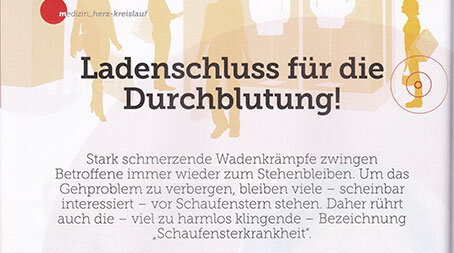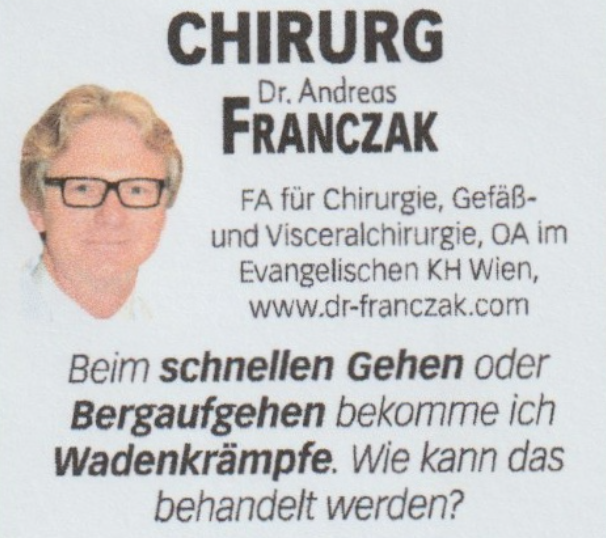Schaufensterkrankheit Arzt, Beinschmerzen Arzt
Bauchhauptschlagader, Beckenschlagader
aorta abdominalis, arteria iliaca, arteria femuralis
Die Bauchhauptschlagader, genannt auch Bauchaorta (Latein: aorta abdominalis) und die Beckenschlagadern, Iliakalarterien (Latein: arteriae iliacae) (rechts und links) sind große Gefäße die das mit Sauerstoff und Nahrungsstoffen versehrtes Blut in den Bauchraum, Beckenregion und in die Beine führen. Diese Gefäße befinden sich im hinteren Anteil des Bauch- Beckenraumes in der Nähe der Wirbelsäule hinter dem Beuchfell (retroperitoneal). Am häufigsten wird die Bauchaorta unterhalb der Abgänge der Nierenarterien (infrarenale Aorta) sowohl von der Verschlußkrankheit wie auch von der Aneurysmabildung betroffen. Es können allerdings auch die Engeweidenschlagadern (Viszeralarterien) von diesen Krankheiten beschädigt werden.
Author: Dr. Andreas Franczak, specialist in surgery, vascular surgery and visceral surgery
Arterielle Verschlusskrankheit (AVK)
Schaufensterkrankheit (periphere Arterielle Verschlußkrankheit – pAVK)
Was ist die pAVK?
With PAOD , what stands for peripheral arterial occlusive disease, the blood supply to the extremities is disturbed. The most common reason for this is an obstruction of the peripheral arteries. Atherosclerosis is a disease where plaque builds up in the lumen of arteries and leads to the narrowing/obstruction of these vessels. Mostly atherosclerosis is the reason of developing PAOD. The first symptoms can be pain and cramping while exercising, later this pain, cramping and tiredness is observed even while walking. The pain mostly stops when the diseased person stops and stands still for a moment. It is called then intermitted claudication. The pain develops because of inadequate blood flow to the muscles.
What are the different stages of PAOD?
It is to mention that PAOD develops in each patient with a different progression.
Stage I is without symptoms , but there can be already found the narrowing of the vessels. Stage II pain occurs while walking , but is relieved at rest; the muscles are not perfused efficiently
Stage III this stage is marked by an increased pain, occurring faster and the pain is not relieved at rest, it might occur spontaneously, specially at night
Stage IV is characterized by necrosis (tissue lost) and gangrene (deep infection) of the affected lower limb. The smallest injury won´t heal probably and general infections can occur If there is no therapy and no reperfusion of the affected blood vessels it can lead to total tissue death and amputation is necessary.
What is the course of PAOD?
As mentioned the course of PAOD is very individual. A lot depends on the possibility to stop the development of atherosclerosis. The more the arteries are obstructed the worse the blood perfusion, the worse the pain. The key for a successful treatment is to lower the risk factors of atherosclerosis (smoking, hypertension, high blood cholesterol, overweight, diabetes mellitus). You as a patient having PAOD can help the most yourself by changing your lifestyle and diet. It might safe you not only from one unpleasant disease, it as well it decreases your risk of experiencing an MI and/or a stroke. During the early stages walk-training and special gymnastic are the basics of the treatment. The goal is to decrease the symptoms and to increase the “pain free walking distance”. Through the training new blood vessels form, which build collaterals and perfuse the muscles. Generally it is said that walking distance, speed and duration should be adapted to the individual condition. At the end stages, with pain at rest, walk training is contraindicated. Only surgical intervention helps here.
Which forms of therapy do exist?
Treating PAOD the physician can administer the patient different drugs which prevent from blood clotting and thrombosis (ex. Acetylsalicylic acid, Clopidrogel…). These drugs are especially used to decrease the risks of MI, Stroke or acute vessel occlusion. Moreover another important drug are Statins. These are blood cholesterol lowering drugs, which are beneficial decreasing atherosclerotic plaque formation. Anticoagulants are used after vascular surgery or when there is a risk of thrombosis in the heart (as seen with arrhythmias or after an MI).
Prostaglandins seem to be beneficial in the treatment of the late stages of PAOD. The best treatment for a patient depends on several factors, on how severe the disease is developed and on the location. The standard treatment is balloon-angioplasty (PTA). It is a mechanical widening of a narrowed or obstructed artery. Additionally there is the possibility of putting a stent into the affected artery to prevent it from another obstruction. In some cases a bypass surgery is the best choice. Hereby the obstructed artery is diverted by using a vein (mostly saphenous vein) or by synthetic material. This is mostly done when necrosis is present or the possible walking distance is very short (stage III-IV). The success of each treatment and therapy depends on how radical and consequent you as a patient decrease your risk factors. The lesser the risk of developing atherosclerosis, the lower is the risk of having obstructed arteries.
Author: Dr. Andreas Franczak


